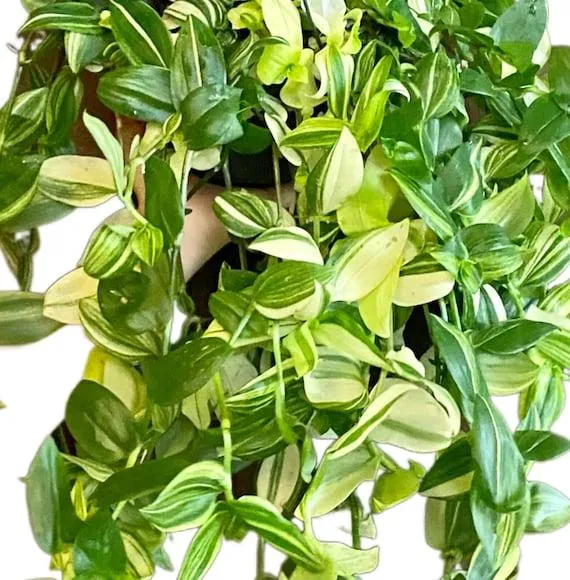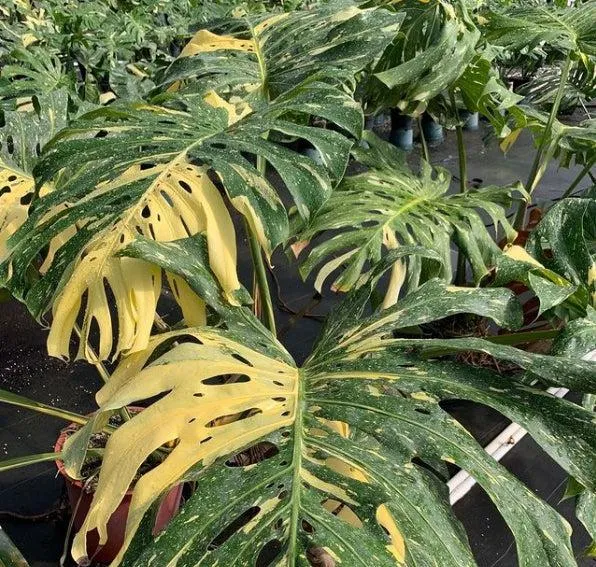Everything You Need to Know About the Monstera deliciosa Yellow Variegated
The Monstera deliciosa, commonly known as the Swiss cheese plant or windowsill plant, is one of the most popular houseplants worldwide thanks to its exotic tropical appearance and ease of care. Within the Monstera genus, a rare yellow variegated cultivar has gained popularity in recent years for its unusual bright yellow markings. If you’ve come across this beautiful plant online or at your local nursery and are eager to learn more, then read on for a comprehensive guide to the Monstera deliciosa yellow variegated.
What Makes It Unique?
- Variegation – Unlike the typical green Monstera, this variant features streaks or splotches of bright canary yellow across its leaves.
- Rarity – Yellow variegated Monstera are much less common than the green cultivars, making them a coveted find among plant collectors.
- High maintenance – Due to the metabolic costs of variegation, these plants require extra care and ideal growing conditions to thrive long-term.
The variegation is caused by a genetic mutation that disrupts the plant’s chlorophyll production in certain areas, leaving them pale yellow. From my experience propagating variegated plants, maintaining the variegation through successive generations can be challenging. The yellow patches tend to fade or disappear over time if the plant is stressed. Proper growing methods are critical to preserve its unique appearance.
Care Requirements
As mentioned, variegated Monstera are more finicky than their green counterparts. They will need:
Bright, Indirect Light – Direct sun can scorch the leaves. East or west facing windows are ideal. I keep mine about 3 feet from a south window.
Consistent Moisture – The soil should be kept continually moist but not soggy. Feel the top inch to determine when to water. Under-watering stresses plants faster than over-watering.
High Humidity – Mist leaves regularly and use a pebble tray or humidifier. Low humidity causes leaf edges to brown.
Fertilizer – Use a diluted liquid houseplant food every 2-4 weeks during the growing season. Variegated plants often struggle to produce adequate nutrients on their own.
Patience – Expect slower growth compared to all-green specimens. Provide the best care possible and appreciate whatever progress it makes! Variegation is a natural handicap.

Following these guidelines closely maximizes your plant’s potential to thrive long-term while retaining its yellow pattern, which can fade or die out otherwise. Stability takes precedence over speedy growth with high-maintenance cultivars.
Pests and Problems
Like other houseplants, Monstera can face issues from pests or cultural mistakes. Some common problems include:
Mealybugs – Fluffy white masses in leaf joints or soil. Wipe with cotton balls dipped in rubbing alcohol.
Spider mites – Webbing on undersides. Neem oil spray or washing leaves in the shower can help control.
Leaf spotting/browning – Too little light, water or humidity. Improve care and trim affected areas.
Yellowing leaves – Overwatering causes root issues. Allow soil to dry more between waterings.
Fading variegation – Not enough light triggers loss of yellow patterns over time. Rotate plant weekly.
Being attentive to any changes in your plant’s appearance and addressing underlying causes early maximizes the chances of a complete recovery. Don’t neglect cultural necessities like light availability.

Propagation
Variegated Monstera can spread naturally through plantlets or be propagated intentionally. Here’s what I’ve learned through trial and error:
– Cuttings root easily in water or soil. Take 6-inch sections with at least one node.
– Place the node end down in moist organic soil. Keep warm and humid. Roots form within a few weeks.
– Water propping works too by submerging the node in water. Change water weekly.
– Variegation stability cannot be guaranteed. New growth may come in all green or with altered patterns.
– Regularly dividing plantlets in their pot preserves the original variegation over time better than single plant specimens.
– Consider propagation as a way to share the beauty and increase availability, not to necessarily make money since true variegation cannot be mass produced.
With careful attention, it is possible to increase your variegated Monstera population while preserving its pale yellow streaks for admiring for years to come. Not a guarantee, but propagation increases the odds.

In conclusion, the Monstera deliciosa yellow variegated is a true collectors plant that requires above average care. But for green thumb enthusiasts intrigued by its unique foliage patterns, the challenge can be extremely rewarding. Following optimal conditions maximizes your chances of enjoying this beautiful tropical beauty for many years indoors. With patience and care, it will surely brighten up any home. Feel free to ask me any other questions!
Monstera Deliciosa Yellow Variegated Care Guide
| Care Tip | Details |
|---|---|
| Light Conditions | Bright, indirect light. Variegated monsteras can burn in direct sun. |
| Watering | Allow soil to dry out between waterings. Water thoroughly when dry and avoid standing water. |
| Humidity | High humidity levels of 50-60% help maintain vibrant variegation. Consider a pebble tray or humidifier. |
| Fertilizing | Feed monthly in spring and summer with a balanced houseplant fertilizer diluted to 1/2 the strength. |
| Pruning | Prune off non-variegated growth to promote more variegated leaves and a full plant shape. |
| Pest Problems | Check regularly for spider mites or mealybugs which thrive in warm, low humidity conditions. |
FAQ
-
What is a monstera deliciosa yellow variegated?
Basically, a monstera deliciosa yellow variegated is a rare type of monstera plant. It’s similar to the regular monstera deliciosa, but its leaves have yellow streaks or splotches in addition to the dark green. These yellow spots are caused by a genetic mutation.
-
How much does a variegated monstera cost?
A variegated monstera can be pretty pricey – sometimes a few hundred bucks for a small plant. The rarer the variegation pattern is, the higher the price. I saw one online recently for like $600! You’d think it was made of gold or something. The cost is so high because the variegation gene is unstable, so it’s hard to propagate more plants with the same streaks. Supply and demand, I guess!
-
What care does a variegated monstera need?
The care for a variegated monstera is pretty similar to a regular monstera deliciosa. It likes bright, indirect light and will climb if given the chance. Be careful not to move it to a spot with stronger light too fast or the leaves could burn. You’ll also want to water when the top inch or two of soil is dry. The variegation can sometimes cause the plant more stress, so monitoring for pests is important. Other than that, treat it like any other monstera.
-
Will the variegation stay stable?
This is perhaps the biggest question! Often with variegated plants, the variegation pattern can become less pronounced or even disappear altogether in subsequent generations. This is because the variegation gene is unstable. Sometimes the original variegation will hold stable, but other times new leaves may come in mostly or all green. So there’s no guarantees the unique color pattern will be retained. Only time will tell!
-
Is the variegated monstera more difficult to care for?
For the most part, no – the care is pretty much the same as a regular monstera deliciosa. However, the variegation can cause the plant more stress. Low humidity or underwatering could make yellow or soggy spots form more easily. The plant also uses up more energy to produce the colorful patterns, so it may grow a bit slower. But as long as you provide optimal growing conditions, a variegated monstera shouldn’t need hugely different care. The main thing is keeping an eye out for stresses that could impact the pretty patterns!
-
How do you propagate a variegated monstera?
Propagating a variegated monstera is done in pretty much the same way as a regular monstera – by planting stem or node cuttings in soil. However, there is a higher chance the new plant won’t exhibit the same variegation due to genetic instability. Still, it’s worth a try! You can also try propagating with tissue culture to better preserve the variegation pattern, but it requires specialized lab equipment. In the end, there are no guarantees, but with some patience you might get a new variegated beauty.
-
Is the variegation permanent?
As mentioned before, variegation patterns in plants can sometimes fade or disappear over time. For monstera deliciosa, the yellow streaks may hold steady for years. But there’s also a chance more leaves could come in mostly green as the plant ages. Growth stresses, too much sun exposure, underwatering – all of these can bring out more green. So while the initial variegation is permanent on established leaves, it’s impossible to say for sure if it will remain on future growth. Time will tell with each unique plant!

